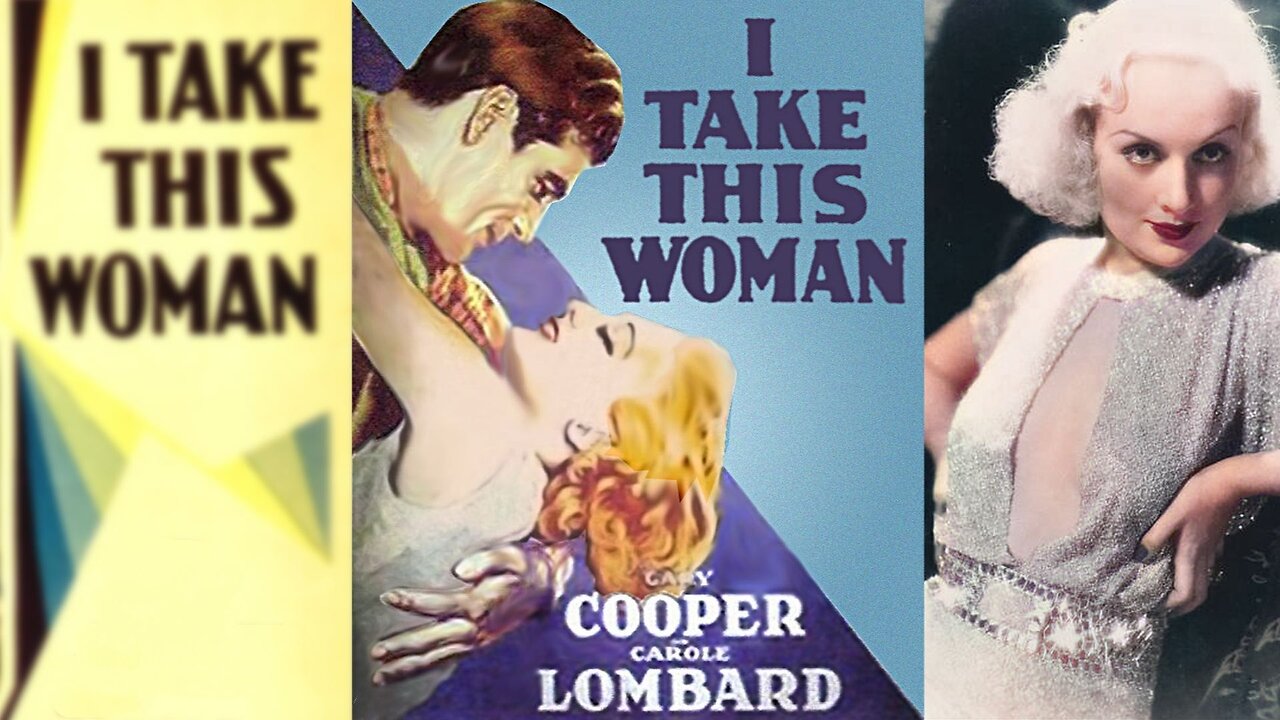Premium Only Content

I TAKE THIS WOMAN (1931) Gary Cooper, Carole Lombard & Helen Ware | Drama, Romance | B&W
I Take This Woman is a 1931 American pre-Code romance film directed by Marion Gering and starring Gary Cooper and Carole Lombard.
Based on the novel Lost Ecstasy (1927) by Mary Roberts Rinehart, the film is about a wealthy New York socialite who falls in love and marries a cowboy while staying at her father's ranch out West. After her father disinherits her, and after a year of living as a cowboy's wife, she leaves her husband and returns to her family in the East. The film was released by Paramount Pictures.
The film has no connection to the 1940 film I Take This Woman starring Spencer Tracy and Hedy Lamarr, which is based on the Charles MacArthur story "A New York Cinderella".
SYNOPSIS
A wealthy New York socialite falls for and marries a cowboy while out West. Her father disinherits her, and after trying to make a go of it as a cowboy's wife, they agree to divorce and she returns back east to her family. However, she soon changes her mind and determines to get her husband back.
After causing yet another scandal, Kay Dowling (Carole Lombard), the spoiled daughter of wealthy New Yorkers, is given a stark choice by her fed-up father (Charles Trowbridge): go to his ranch in Ursula, Wyoming, (to avoid being named a co-respondent in a divorce case) or be disinherited. Kay's fiance, Herbert Forrest (Lester Vail), proposes getting married immediately, but she chooses the ranch.
Later, while spending her days on the ranch with her good-humored aunt Bessie, Kay falls reluctantly in love with one of her father's cowhands, Tom McNair (Gary Cooper), and impulsively marries him. When her father learns of the union, he disowns her. Kay and Tom are forced to live in a one-room shack while Tom tries to expand his cattle herd.
One year later, Kay is unhappy with life on the ranch, and longs for the comforts of her family's palatial mansion. One day, she receives a telegram from home, and tells Tom that her father is sick and that she must be with him. Back in New York, Kay writes a letter to Tom, asking for a divorce. Soon after, Tom arrives at the estate and explains that he left the ranch to become a professional bronco rider in a rodeo. Kay assumes that he never received the letter, and Tom never mentions it. One night during a party, Tom overhears the guests making fun of him and he confronts Kay, telling her that he did receive her letter, and made the trip to determine whether or not she still loved him. Satisfied with what he has learned, he tells her she can have her divorce. Later, as she realizes that life with Herbert would amount to a life of playing golf, Kay visits Tom at the rodeo. During his performance, he is thrown from a bronco and hurt. Kay rushes to Tom's side, and the two reconcile and decide to return to the ranch.
CAST & CREW
Gary Cooper as Tom McNair
Carole Lombard as Kay Dowling
Helen Ware as Aunt Bessie
Lester Vail as Herbert Forrest
Charles Trowbridge as Mr. Dowling
Clara Blandick as Sue Barnes
Gerald Fielding as Bill Wentworth
Al Hart as Jake Mallory
Guy Oliver as Sid
Syd Saylor as Shorty
Mildred Van Dorn as Clara Hammell
Leslie Palmer as Phillips
Ara Haswell as Nora
Frank Darien as Station agent
David Landau as Circus boss
Directed by Marion Gering
Screenplay by Vincent Lawrence
Based on Lost Ecstasy by Mary Roberts Rinehart
Cinematography Victor Milner
Production company Paramount Pictures
Distributed by Paramount Pictures
Release date June 27, 1931 (USA)
Running time 72 minutes
Country United States
Language English
NOTES
I Take This Woman marked the film debut of Russian-born director Marion Gering, who had previously directed stage plays.
Produced under the working titles Lost Ecstasy, Rodeo Romance, Half Angel, and In Defense of Love, the film was ultimately titled I Take This Woman by Paramount studio heads in order to "emphasize the romance rather than the western setting, and reflect more of the boy's role than the girl's".
Cooper and Lombard reportedly had an affair during the filming.
This film apparently became an "orphan film" when the rights reverted to author Mary Roberts Rinehart. The original 35mm camera negative and all supporting material was shipped back to her, but she had no interest in (or appropriate storage for) the material. She disposed of the 35mm camera negative and retained only a 16mm print. A single surviving 35mm nitrate studio print became the basis for a restoration, funded by the Louis B. Mayer Foundation. The restored print was screened in March 2017 at the Festival of Preservation at the UCLA Film and Television Archive.
#oldmovies #freemovies #drama #romance #classicfilms #freemoviesonline #blackandwhite #lostandfoundfilms
-
 8:27
8:27
Lost n Found Films
3 days agoA DETECTIVE STORY (1929) Podcast | Thriller | Nostalgic Flick
531 -
 13:53
13:53
TundraTactical
4 hours ago $0.58 earnedFudd Finder : 11 Questions Second Amendment Questions (And Roasts) to Ask Your Friends
13.5K -
 LIVE
LIVE
Wayne Allyn Root | WAR Zone
5 hours agoWAR Zone LIVE | 5 SEPTEMBER 2025
98 watching -
 1:39:50
1:39:50
The White House
5 hours agoPresident Trump Makes Announcements, Sep. 5, 2025
27.6K19 -
 LIVE
LIVE
Red Pill News
3 hours agoBombshell Biden Docs Invalidate Autopen Pardons on Red Pill News Live
3,198 watching -
 9:36
9:36
Silver Dragons
3 hours agoGold Price NEW ALL TIME HIGH - $5,000 GOLD NEXT?
12.5K5 -
 LIVE
LIVE
LFA TV
12 hours agoLFA TV ALL DAY STREAM - FRIDAY 9/5/25
836 watching -
 13:43
13:43
The Kevin Trudeau Show Limitless
2 days agoClassified File 3 | Kevin Trudeau EXPOSES Secret Society Brainwave Training
94.3K18 -
 1:11:24
1:11:24
vivafrei
7 hours agoDearborn Heights Police Have Been CONQUERED! Gender Madness on PASSPORTS! Canada Stuff & MORE!
90.7K54 -
 1:44:43
1:44:43
The Quartering
6 hours agoConservative Scam Busted, Black Fatigue Hits Airlines, Kimmel Meltdown
114K45